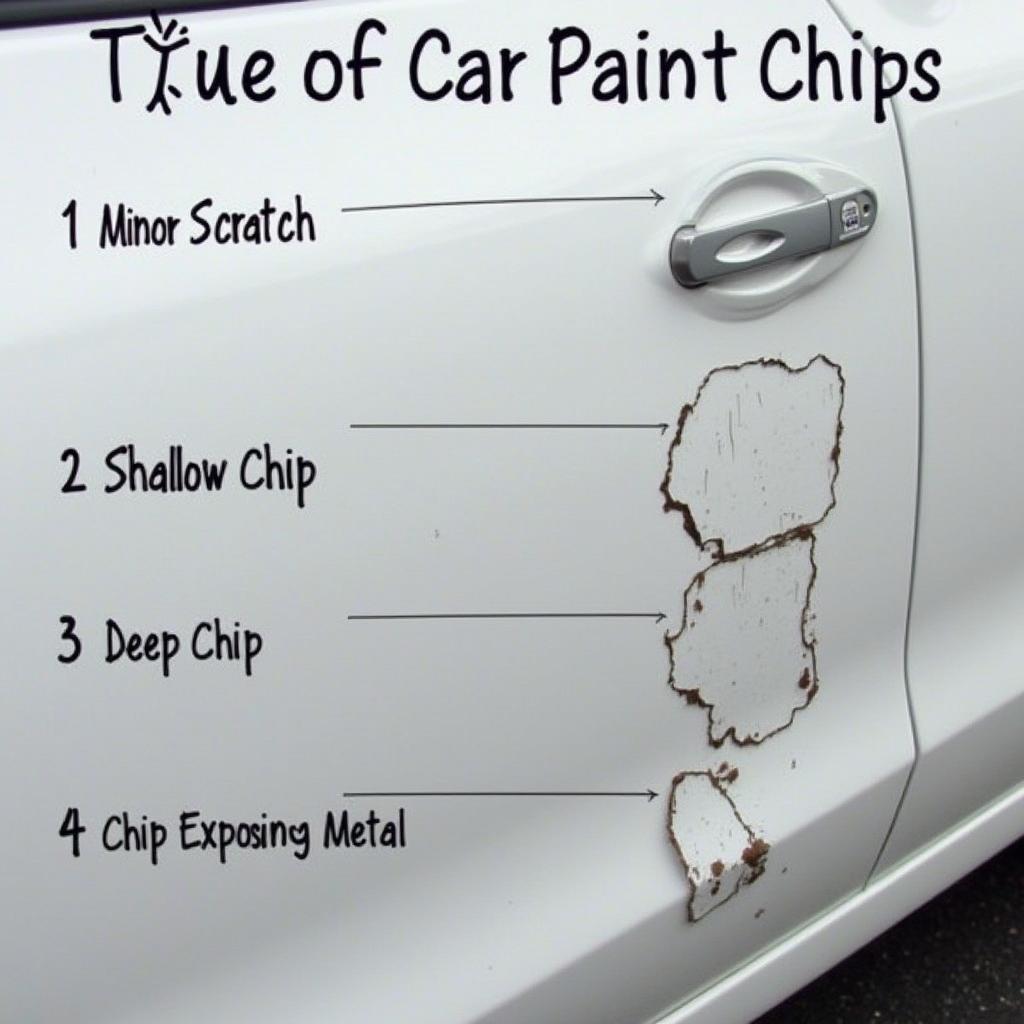Few things are more frustrating than discovering a paint chip on your vehicle. Whether it’s from a stray rock on the highway or a rogue shopping cart in the parking lot, these small blemishes can detract from your car’s appearance and even lead to rust and corrosion if left untreated. Fortunately, car paint chip repair is a manageable task that can often be tackled by car owners themselves. This comprehensive guide will delve into the intricacies of car paint chip repair, equipping you with the knowledge and techniques to restore your car’s finish to its former glory.
Understanding Car Paint Chips: Types and Severity
Before diving into the repair process, it’s crucial to assess the type and severity of the paint chip you’re dealing with. This assessment will dictate the appropriate repair method and materials needed.
- Chip Depth: Paint chips are categorized by their depth, ranging from minor scratches on the surface to deep gouges that expose the bare metal.
- Chip Size: The size of the chip also plays a significant role. Tiny chips might only require touch-up paint, while larger chips might necessitate more extensive repairs, such as repainting a panel.
- Rust Formation: Rust is a telltale sign that a paint chip has penetrated the metal substrate. Rust requires immediate attention, as it can spread quickly and cause significant damage if left untreated.
DIY Car Paint Chip Repair: Effective Methods for Minor Chips
For minor paint chips that haven’t penetrated the primer layer, DIY repair is often a viable option. Here’s a step-by-step guide:
- Clean the Area: Thoroughly wash the area around the chip with soap and water to remove dirt, debris, and wax. Use a microfiber cloth and isopropyl alcohol to further clean the chip itself, ensuring a pristine surface for repair.
- Sand if Necessary: If the chip has rough edges, use fine-grit sandpaper (2000-grit or higher) to gently smooth them out. Be careful not to sand down to the bare metal.
- Apply Touch-Up Paint: Using a fine-tipped paint touch-up pen or brush, carefully apply thin layers of touch-up paint to the chip. Allow each layer to dry completely before applying the next. It’s better to apply multiple thin coats than one thick coat, as this will prevent the paint from bubbling or running.
- Level the Surface: Once the touch-up paint has dried completely, use a rubbing compound and a soft cloth to level the repaired area with the surrounding paintwork.
- Apply Clear Coat: If desired, you can apply a clear coat over the repaired area to protect it and enhance its shine.
“Remember,” advises John Smith, an automotive paint specialist with over 20 years of experience, “patience is key when it comes to DIY paint chip repair. Taking your time and applying thin coats of paint will yield the best results.”
Professional Car Paint Chip Repair: When to Seek Expert Assistance
While DIY repairs are suitable for minor chips, more severe damage often necessitates the expertise of a professional car paint chip repair specialist. Consider seeking professional help if:
- The chip is large or deep: Chips that are larger than a pencil eraser or have penetrated the primer layer require professional attention to ensure proper adhesion and a seamless finish.
- Rust is present: Rust requires specialized treatment to prevent it from spreading. Attempting to repair a rusty chip yourself can worsen the damage.
- You lack the necessary tools or experience: If you’re uncomfortable with the repair process or lack the necessary tools, it’s best to leave it to the professionals.
Professional repair shops have the expertise, equipment, and paint-matching capabilities to deliver flawless results. They can address rust, feather the paint edges seamlessly, and apply a durable clear coat that will protect your car’s finish for years to come.
Preventing Car Paint Chips: Protecting Your Vehicle’s Finish
Prevention is always better than cure. Here are some effective measures to safeguard your car’s paint from chips:
- Maintain a Safe Following Distance: Rocks and debris kicked up by vehicles ahead are a common cause of paint chips.
- Park Strategically: Choose parking spots away from high-traffic areas and avoid parking under trees that might drop sap or bird droppings.
- Wash Your Car Regularly: Regular washing removes abrasive dirt and grime that can scratch your car’s paint.
- Apply a Paint Protection Film: Consider investing in a clear paint protection film (PPF) for vulnerable areas like the hood, bumpers, and mirrors.
By implementing these preventive measures and addressing paint chips promptly, you can keep your car looking its best for years to come. Remember, a small investment in car paint chip repair or prevention can go a long way in preserving your vehicle’s value and appearance.



